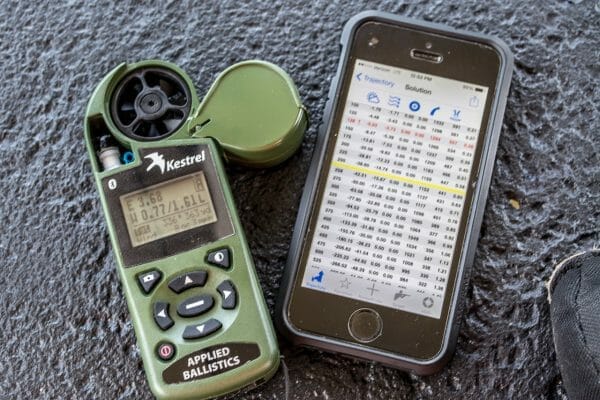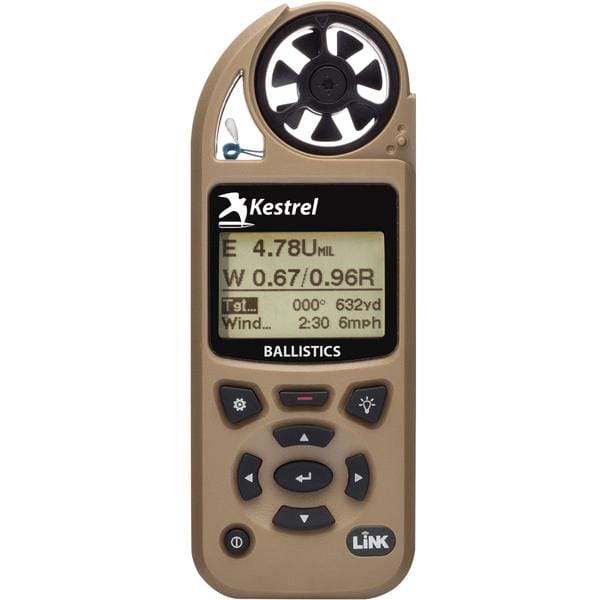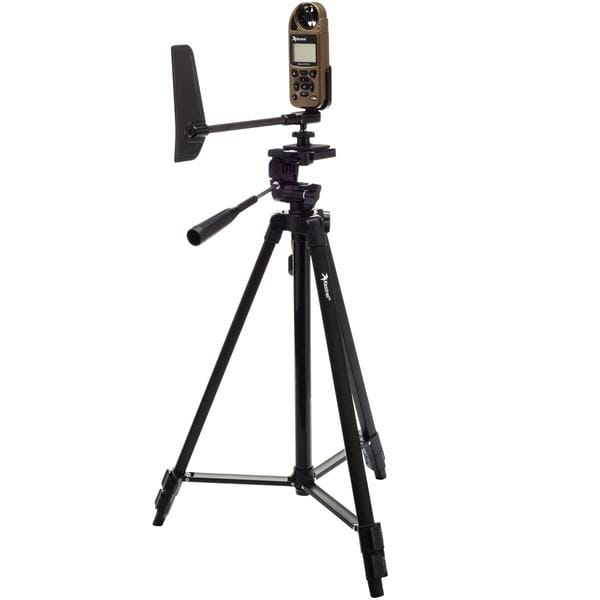Learning to Read the Wind for Long Range Shooting

USA –-(Ammoland.com)- If wind were abiding similar gravity, making long-range first shot hits would be piece of cake. Just let your ballistic calculator do the math and printing the trigger properly.
However, the wind isn't abiding—it'south ever changing, often second to second. To add complexity to the matter, it'southward not at all uncommon for current of air conditions to change throughout the distance of your shot. In terrain with obstructions, whether man-made or natural, yous might have a completely unlike current of air speed and direction at your shooting position every bit at the target.
For these reasons, the "skill" part of good long-range shooting is knowing how to gauge the wind accurately and consistently. Let's talk over a few means to exercise that.
Technology!
Nosotros alive in the age of First Globe problems like worrying about whether we've got spare batteries for our shooting gear. Tools similar weather meters, ballistic computers, and laser range finders are now commonplace and surprisingly affordable for what they practise. Most of these tools are reliable enough for tough field use.

One "must accept" tool for long-range shooters is the Kestrel 5700 Ballistics Atmospheric condition. This nifty piddling tool is about the size of a smartphone and measures real-fourth dimension weather condition conditions including wind speed and direction. While the device has a not-insignificant learning curve to figure out all the functions, getting basic wind measurements is simple. Just point it into the wind and let the capture fashion run. If you lot're a trivial unsure as to the air current direction, but keep moving information technology until yous get a maximum velocity reading while the wind feels steady. It'll capture the minimum, maximum, and average current of air speed then if you're shooting between gusts; y'all'll have a reading on that constant "between the gusts" cakewalk.
The Kestrel is smart enough to know from which compass heading the wind is bravado. You tin can likewise point it at your target to capture that directional input. With these two pieces of information, the device knows the angle and speed of the current of air relative to your shot. Assuming y'all've input your armament information, the rest is automatic. The Kestrel will tell y'all exact low many clicks, mils, or minutes of angle to suit to account for current of air. (Sweet Must Take Item: Kestrel Rotating Vane)

In open field atmospheric condition, the Kestrel tin give you lot all the information you need. Unless your shooting position is blocking current of air, you'll have similar conditions from you lot to the target, so measuring air current at your position will practise the chore. However, if y'all are shooting in urban areas, a country populated by copse, or in the hills, you'll also need ways to gauge wind conditions and directions way out there. That's where some old schoolhouse wind measurement tips become handy.
Figuring Out Wind Information the Old-Fashioned Mode
If yous don't have a fancy electronic device or if you need to gauge current of air atmospheric condition far away from your shooting position, there are several means to calculate wind speed and direction. There are plenty of useful tools in virtually whatsoever environs to provide the data you need. Fifty-fifty if you're shooting in a giant parking lot with no grass, shrubs, grit, or trees, you tin still make up one's mind air current speed. Read on.
You lot can use grass, trees, bushes, and basis debris to assistance you guess wind speed based on how diverse objects move in reaction to the current of air. For calm atmospheric condition, y'all can also use smoke if available. Smoke (or air as yous'll meet in a minute) is perchance the well-nigh sensitive indicator, so if you see minimal smoke movement laterally, wind speed is probably less than 3 mph.
If you take a good scope, or better yet a spotting scope, you can also apply delusion to estimate wind speed. Delusion is the "estrus wave" effect you lot see in the form of moving and jiggly air when your lens is just out of focus. Wait through the spotting telescopic at your target and united nations-focus a bit until you see some shimmer. Every bit you view these "waves", y'all'll be able to see the management in which the wind is blowing them. With no wind at all, the wavy lines will exist vertically oriented.
three – 5 mph
In this range, you'll feel a steady but light cakewalk on your face. Be certain to concentrate on what you lot experience on your ears unless they're tucked under a lid. If you are able to see the mirage, the wave lines volition be roughly following the angle represented by 5 and 11 o'clock (or 7 and i o'clock) positions.
5 – 8 mph
Trees tin can help you here. Look to come across if leaves, only not branches, are moving continuously. Mirage lines will be oriented at about a 45-degree angle.
8 – 12 mph
As the wind picks upward past the moving leaves phase, look back to the basis. Between 8 and 12 mph, things similar newspaper, leaves, and grit volition brainstorm to motion around on the footing.
12-fifteen mph
In this range, branches, small trees, and shrubs start to motion and sway.
15+ mph
Larger trees and branches will movement. On the other manus, this is a terrible twenty-four hour period to be shooting long-range targets. Unless your life or a vitally of import mission depends on making a shot in these conditions why on world are yous trying to brand precise long-distance shots in this kind of wind? For targets with big backstops, information technology can certainly be fun. Simply don't shoot beyond your skill and the conditions if there are serious ramifications to misses or off-center hits – similar hunting.

What about wind management?
Knowing the wind velocity is simply have the battle. Accurately determining its direction is the other half. While you can go an idea of direction from delusion, information technology'southward harder to get a precise angle relative to your shot, and then you'll desire to use other indicators. Grass is a good one since the pattern is easy to see directionally. Small-scale copse and shrubs work if at that place's enough wind, and smoke is groovy if there's whatever in the area. You can always practise the erstwhile golfer's trick and toss some blades of grass or light ground debris in the air to see how information technology falls.
Don't forget…
Depending on your position, you lot may demand to focus on what'southward going on with the wind everywhere Simply where you're situated. If you're in a partially enclosed pavilion, your sniper hidey-pigsty or the wood, the air current speed at your shooting position may be far less than it is downwardly range. If you measure with a meter at your position, exist sure to double bank check down range conditions using the manual methods previously discussed.

Nearly
Tom McHale is the author of the Applied Guides book serial that guides new and experienced shooters alike in a fun, outgoing, and practical style. His books are bachelor in print and eBook format on Amazon . Yous tin likewise discover him on Facebook, Twitter, Instagram and Pinterest.
Source: https://www.ammoland.com/2018/12/how-to-estimate-wind-long-range-shooting/
0 Response to "Learning to Read the Wind for Long Range Shooting"
Enregistrer un commentaire